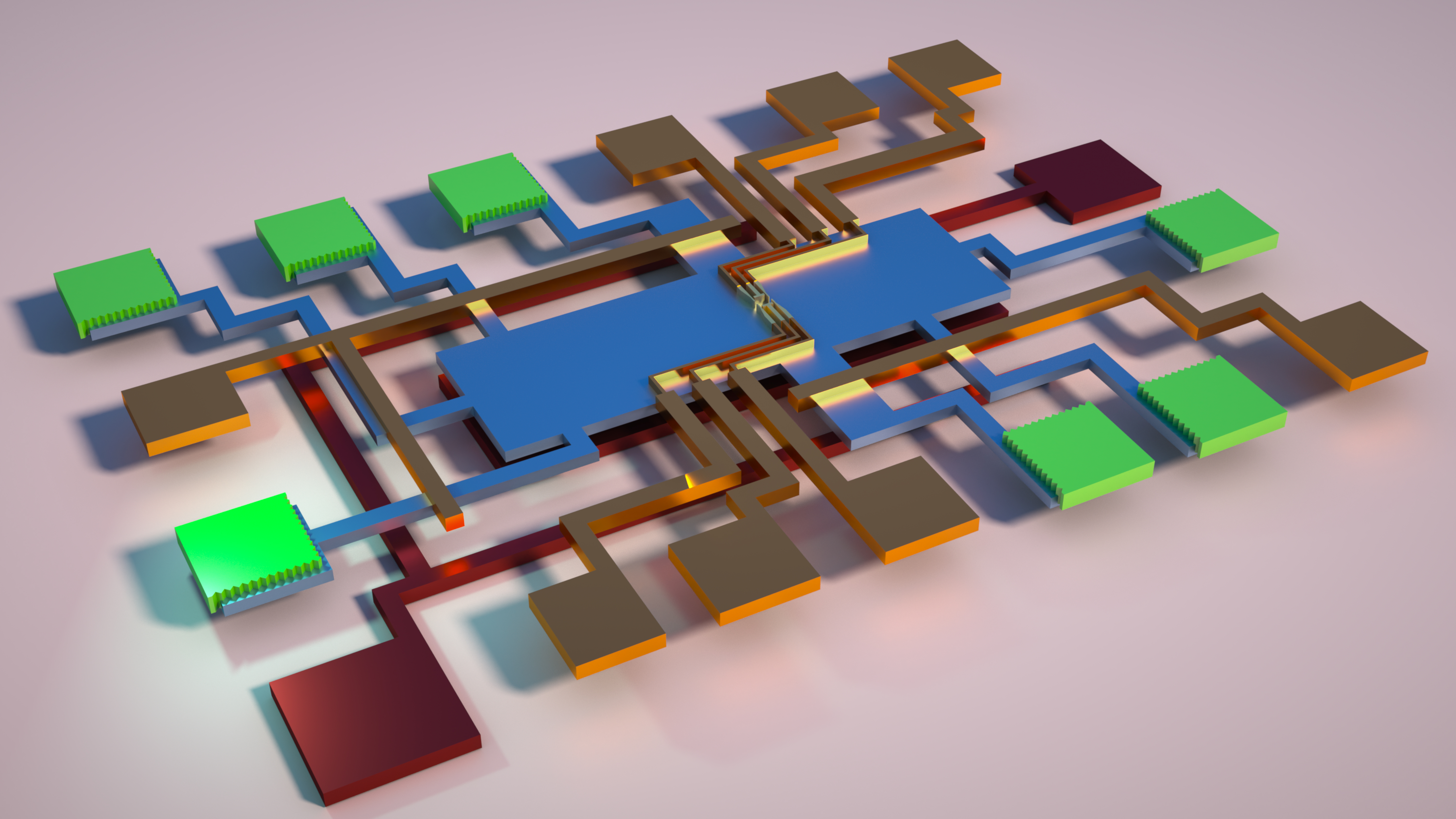Fabry-Pérot interferometers peer into the hidden world of quantum mechanics and coherent electron transport
2025-08-21

Artistic rendering of a Fabry-Pérot interferometer like the one constructed in AlGaAs/GaAs heterostructures pioneered at Purdue. (Photo courtesy/Michael Manfra)
Researchers at Purdue University have used a device called a Fabry-Pérot interferometer to resolve a mystery concerning how electrons organize themselves in certain quantum Hall states. Electrons mostly prefer to act individually, behaving as lone wolves. But under unusual circumstances, like those found in a superconductor, electrons can form bonding pairs, performing a well-choreographed dance with one another.
The mystery arose when an experiment reported in the literature was interpreted as evidence for electron pairing in the integer quantum Hall regime. This is a regime in which electrons usually act as individuals and do not pair. The latest experiment from the Purdue group reported in Nature Communications clearly establishes that single electron interference is responsible for the observed behavior and demonstrates how finely controlled interferometers can be used to probe the quantum-mechanical properties of coherent electron transport in the quantum Hall regime, a tool the team calls an "anyon transistor."
The research was led by Michael Manfra, the Bill and Dee O'Brien Distinguished Professor of Physics and Astronomy who conceived the project, supervised the research, and co-wrote the manuscript. Shuang Liang, a postdoctoral researcher, measured the device, analyzed the data, and co-wrote the manuscript. James Nakamura, a former Purdue postdoctoral researcher, fabricated the interferometer. Geoffrey Gardner, now with Microsoft Quantum, and Liang grew the semiconductor heterostructure by molecular beam epitaxy.
Electronic Fabry-Pérot interferometers are a microscope to observe the coherent quantum mechanical transport of electrons. Just as a glass interferometer can split and recombine beams of light to reveal hidden details, these devices guide electrons along edges of a two-dimensional electron liquid and force them to interfere. Subtle patterns in this interference carry information about the underlying quantum state.
In 2020, Purdue physicists used a Fabry-Pérot interferometer to make the first experimental observation of anyon braiding. Anyons are exotic quasiparticles with fractional charge and unusual exchange statistics. In this new work, the same device architecture has been used to test whether electrons at the edge of an integer quantum Hall state behave as paired particles, or as single electrons.
"Our detailed study demonstrates that this pairing does not occur, the charge carriers remain single electrons, and the apparent pairing is just a manifestation of the properties of the edge states circulating around the boundary of the Fabry-Pérot interferometer. The reason we can definitively explain heretofore mysterious behavior is the fine level of control we now have in our devices," says Manfra.
In a conventional transistor, applying a voltage controls the flow of electrons in a circuit, switching current on and off. In the Purdue device, the applied voltages shape the paths that anyons or electrons take around the interferometer. Unlike classical transistors, the system is probing the quantum interference of exotic particles, yet the analogy holds because the device's behavior can be modeled and controlled with fundamental operating principles.
"Our Fabry-Pérot interferometers are the anyon transistor that allows us to understand in fine detail coherent transport effects and the quantum-mechanical properties of electrons in reduced-dimensional electron systems," explains Manfra.
"This type of innovative research thrives at Purdue with its collaborative ecosystem and state-of-the-art facilities. Our in-house capability is crucial, because probing fragile quantum states requires not only ultrapure semiconductor crystals but also precision nanofabrication and ultracold measurement capabilities," adds Manfra.
Manfra is the director of the Purdue Quantum Science and Engineering Institute (PQSEI) and the Microsoft Quantum Lab West Lafayette, fostering interdisciplinary work in quantum information science.
This research is sponsored by the U.S. Department of Energy, Office of Science, Office of Basic Energy Sciences, under award number DE-SC0020138.
About Purdue Quantum Science Engineering Institute (PQSEI)
PQSEI is the hub for quantum research at Purdue. It convenes more than 60 affiliated faculty working collaboratively to develop technologies that will revolutionize the way we communicate, compute, and sense the world around us. PQSEI connects stakeholders across industry, government, and academia to drive scientific innovation and economic growth. Purdue University is a member of the Chicago Quantum Exchange and the Quantum Science Center based at Oak Ridge National Laboratory and directs the Center for Quantum Technologies, a statewide collaboration with Indiana University, Notre Dame University and 12 industry partners.
About the Department of Physics and Astronomy at Purdue University
Purdue's Department of Physics and Astronomy has a rich and long history dating back to 1904. Our faculty and students are exploring nature at all length scales, from the subatomic to the macroscopic and everything in between. With an excellent and diverse community of faculty, postdocs and students who are pushing new scientific frontiers, we offer a dynamic learning environment, an inclusive research community and an engaging network of scholars.
Physics and Astronomy is one of the seven departments within the Purdue University College of Science. World-class research is performed in astrophysics, atomic and molecular optics, accelerator mass spectrometry, biophysics, condensed matter physics, quantum information science, and particle and nuclear physics. Our state-of-the-art facilities are in the Physics Building, but our researchers also engage in interdisciplinary work at Discovery Park District at Purdue, particularly the Birck Nanotechnology Center and the Bindley Bioscience Center. We also participate in global research including the Large Hadron Collider at CERN, many national laboratories (such as Argonne National Laboratory, Brookhaven National Laboratory, Fermilab, Oak Ridge National Laboratory, the Stanford Linear Accelerator, etc.), the James Webb Space Telescope, and several observatories around the world.
Written by: David Siple, communications specialist, Purdue University Department of Physics and Astronomy